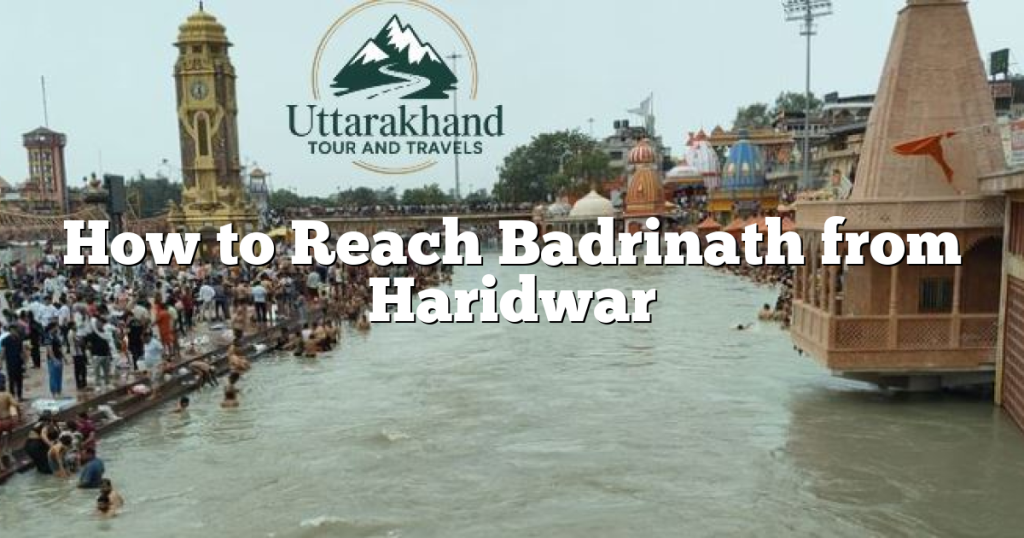Badrinath is one of the most revered pilgrimage sites in India, nestled high in the Garhwal Himalayas of Uttarakhand. It is dedicated to Lord Vishnu and is one of the four principal shrines (Char Dhams) in India and also a part of the smaller Char Dham Yatra in Uttarakhand. Reaching Badrinath from Haridwar is a long and scenic journey through the mountains, primarily by road.
Distance Between Haridwar and Badrinath
Badrinath is the most distant of the Uttarakhand Char Dhams from Haridwar:
- By Road: Approximately 315-330 kilometers.
How to Reach Badrinath from Haridwar
As Badrinath is located at a high altitude and in a remote mountainous region, direct train or flight services are not available. Road travel is the sole practical way to reach the temple.
- Journey Time: The road journey from Haridwar to Badrinath typically takes between 10 to 12 hours, depending on factors like traffic, road conditions, and the number of stops you make. Due to the significant travel time, pilgrims often plan for an overnight halt along the way.
1. By Road (The Primary Mode of Transport)
The journey to Badrinath is known for its breathtaking views of the Himalayas, deep valleys, and the meandering Alaknanda River. The route passes through several significant towns and river confluences (Prayags).
- Route: The most common and direct route is via NH7 (formerly NH58): Haridwar – Rishikesh – Devprayag – Srinagar – Rudraprayag – Karnaprayag – Nandprayag – Joshimath – Badrinath. The road is motorable right up to the Badrinath Temple.
a. By Bus (Economical Option)
Regular bus services, both government-operated and private, connect Haridwar to Badrinath, especially during the pilgrimage season.
- Where to Find Them: Buses usually depart from the main Haridwar ISBT (Inter State Bus Terminal) or the Rishikesh Bus Stand.
- Operators: Uttarakhand Transport Corporation (UTC) and private operators like Garhwal Motor Owners Union (GMOU) and Tehri Garhwal Motor Owners Corporation Pvt Ltd (TGMOC) run services on this route.
- Types of Buses: Primarily non-AC seater buses. While some private operators might advertise “Volvo” or “Push Back” options, these are generally comfortable non-AC vehicles suitable for mountain travel.
- Journey Time: Expect the bus journey to take around 12-13 hours or more, given the mountain roads, numerous stops, and potential traffic. Buses typically depart very early in the morning (e.g., between 3:15 AM and 5:30 AM) to ensure they reach Badrinath before nightfall.
- Ticket Price Estimates: Fares for a one-way bus ticket from Haridwar to Badrinath can range from ₹850 to ₹1,000 per person.
- Pros: Most economical way to travel for individual pilgrims.
- Cons: Very long and can be tiring. Buses make frequent stops. Road conditions can cause delays. Can be crowded, especially during peak Yatra season. Not ideal if prone to motion sickness.
- Tips: Book your tickets well in advance, especially if traveling during the peak season (May-June). Arrive at the bus stand early to secure your seat. Carry light snacks, water, and motion sickness medication if needed.
b. By Private Taxi/Cab (Most Comfortable and Flexible)
Hiring a private taxi or cab is a popular choice for families or groups, offering comfort and flexibility.
- Where to Find Them: You can find pre-paid taxi counters at Haridwar Railway Station, the bus stand, or through various local taxi services and tour operators throughout Haridwar.
- Pros: Door-to-door service directly to Badrinath Temple. Allows for flexible stops for breaks, meals, and photo opportunities at scenic spots like Devprayag, Rudraprayag, and Joshimath. More comfortable for the long journey.
- Cons: More expensive than bus travel.
- Price Estimates: A one-way private taxi from Haridwar to Badrinath can cost anywhere from ₹6,500 to ₹10,000 for a sedan (like Dzire/Etios) and ₹9,000 to ₹18,000 for an SUV (like Ertiga/Innova), depending on the car type, service provider, inclusions (tolls, state taxes, driver allowance), and the season. Many operators offer multi-day packages if you plan to stay in Badrinath or combine it with Kedarnath (Do Dham Yatra).
- Tips: Book from reputable taxi services. Negotiate the fare clearly and confirm all inclusions (e.g., tolls, parking, driver’s night halt charges) upfront to avoid surprises. An experienced driver who is familiar with the mountain roads is highly recommended.
c. Self-Drive (For Highly Experienced Mountain Drivers)
Self-driving to Badrinath is an option for very experienced drivers who are comfortable with long drives and challenging Himalayan roads.
- Pros: Complete freedom and flexibility to set your own pace, stop as often as you like, and explore along the route.
- Cons: Extremely long and potentially tiring drive. Mountain roads can be narrow, winding, and prone to landslides during monsoon or ice/snow in early/late season. Limited and often paid parking available at Badrinath. Driving at night on these roads is highly unsafe and strongly discouraged.
- Tips: Ensure your vehicle is in excellent condition, especially brakes, tires, and lights. Carry all necessary vehicle documents, a spare tire, and a basic toolkit. Always check weather and real-time road conditions before and during your journey.
2. By Train or Air (Not Practical)
- By Train: Badrinath does not have a railway station. The nearest major railway station is Rishikesh (RKSH), which is approximately 295 km from Badrinath, and Haridwar (HW) itself is about 315 km. From Rishikesh or Haridwar, you must continue your journey by road.
- By Air: Badrinath does not have an airport. The nearest airport is Jolly Grant Airport (DED) in Dehradun, approximately 317 km away. While you can fly to Dehradun from major Indian cities, there are no direct flights from Haridwar to Dehradun. From Dehradun, you would still need to embark on a long road journey to Badrinath.
Important Considerations for Visiting Badrinath
- Yatra Season (Opening and Closing Dates): Badrinath Temple is typically open only for about six months of the year, from late April/early May to October/early November, as it remains closed during winter due to heavy snowfall. The exact opening and closing dates are announced annually. For 2025, the temple is scheduled to open on May 4, 2025.
- Pilgrim Registration: If you are traveling during the Char Dham Yatra season, biometric registration is often mandatory. You can complete this online or at designated counters in Haridwar, Rishikesh, and other points along the route.
- Road Conditions: The roads to Badrinath are part of the Border Roads Organization (BRO) network and are generally well-maintained, but they are still mountainous and winding. Landslides can occur during the monsoon season (July-August), causing delays or temporary road closures.
- Altitude and Weather: Badrinath is at a high altitude (around 3,100 meters or 10,200 feet). The weather can be cold and unpredictable, even in summer. Carry layers of warm clothing, rain gear, and comfortable shoes. It’s advisable to acclimatize gradually to avoid acute mountain sickness (AMS).
- Accommodation and Food: Badrinath town offers a range of accommodation options, from basic dharamshalas and guesthouses to hotels, especially during the Yatra season. Food is readily available at various eateries.
Reaching Badrinath from Haridwar is a memorable pilgrimage that combines spiritual devotion with the awe-inspiring beauty of the Himalayan landscape. Plan your journey carefully, prepare for the long drive, and be ready for a truly divine experience.









